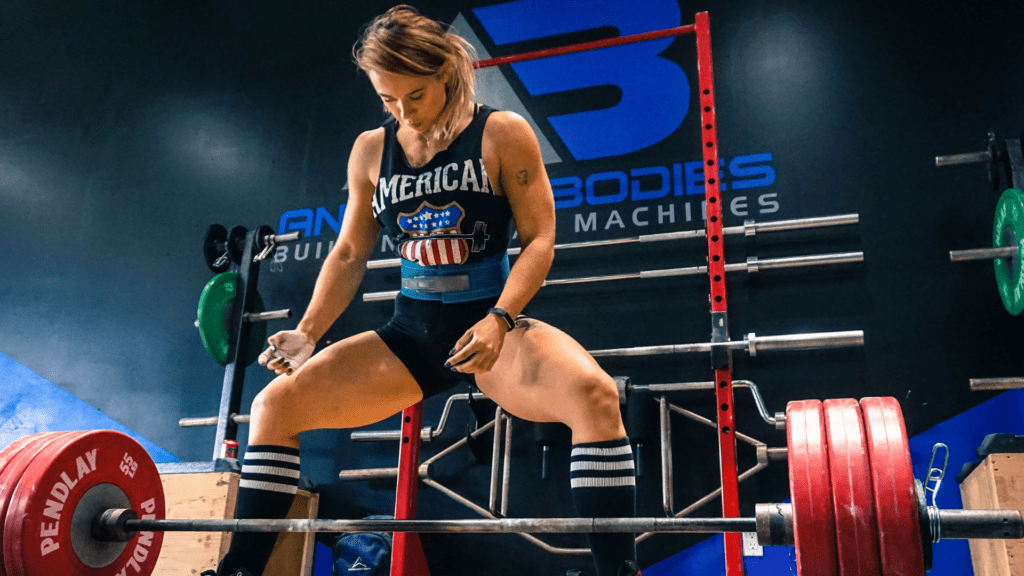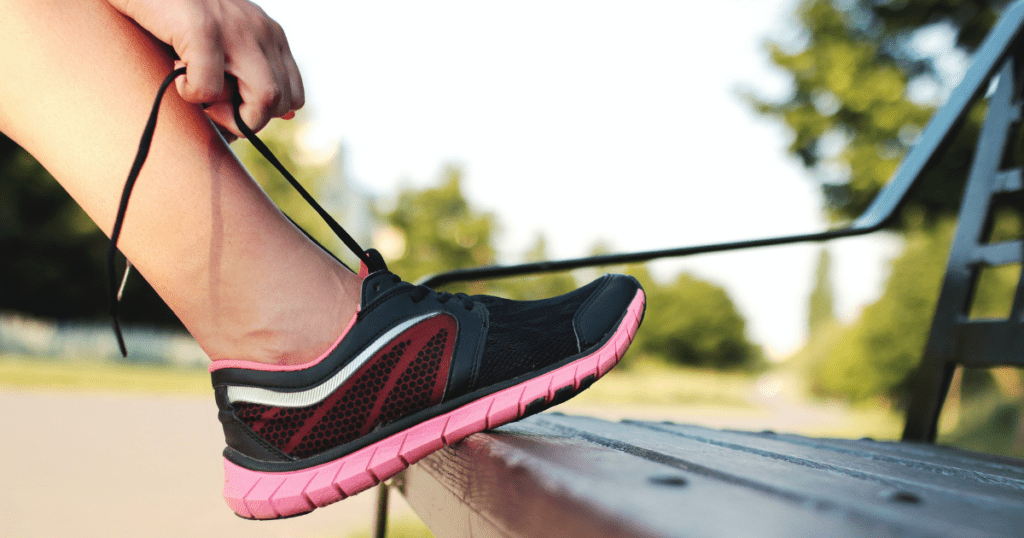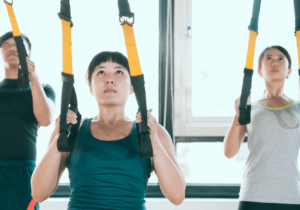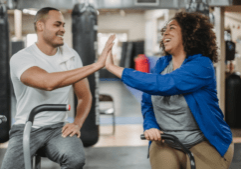Create a workout weekly routine with three different types of exercise
Good Things Come to Those Who Move
We’ve all heard about the importance of exercise and a workout weekly routine. But deciphering what constitutes exercise and how much of it you “need” can feel like you’re pedaling a bicycle, going around and around in circles with no clear destination.
Exercise, training, and everyday movement are three unique forms of working out, and all three types of exercise have a place in a healthy lifestyle. At the very minimum, finding ways to move your body more can have a major impact on how you feel every day. So, what’s the difference between the three types of movement? And do you need all of them?
Exercise
Exercise is getting your heart rate up for a sustained period of time while performing some kind of movement, preferably one you enjoy. It’s generally a planned and structured activity.
Cycling. Walking at a brisk pace. Running. Swimming. Horseback riding. Softball, baseball, tennis, pickleball. You get the picture.

Regular exercise is healthy for a myriad of reasons, but I’m guessing those reasons have been crammed down your throat for years. Instead of reiterating why it’s important, my question to you is, how does exercise make you feel? If your answer is “not good,” then you might be doing the wrong kind for you.
For instance, I despise running. Always have. So, if someone told me I should be running 30 minutes a day, three days a week, there’s probably little chance I would make an effort to exercise. But because I love swimming, I would look forward to hitting the pool a few times a week.
My workout weekly routine generally involves two days of cycling and one or two days of dance cardio or HIIT videos, and now and then I mix it up with a trip to Jazzercise. But then I also “train” twice a week. So, what does that mean?
Tip: Here are six of my favorite dance cardio videos and one HIIT session you can try from the privacy of your own home if you’re shy about working out in public
Training
The difference between training vs exercising generally means following some kind of program with the explicit goal of progressively adding more weight, reps, or increasing or decreasing time-based on the activity.
For example, strength training might mean using a program that helps you work toward adding more weight to the bar or a higher rep scheme. For runners or swimmers, a program might be aimed at helping shave off time.

Or for recreational cyclists, a program might help them build stamina so they can increase their riding time or be able to complete a 100-mile ride.
When my husband and I started powerlifting over 12 years ago, we followed Wendler’s 5/3/1 method to gradually increase our weights. We’ve since switched to the Starting Strength method.
Another fantastic resource for training is the programs designed by Balanced Healthstyle coaches, which include demo videos of the form.
For years, our goal was to continue increasing our one-rep maximums. Now that we’re older, we’re more focused on types of exercise that maintain muscle mass. So, we still train consistently, but our training goals are a bit more modest and dedicated to adding smaller amounts of weight to the bar. Recognize that things change as you get older and that you may need to switch up your training routine based on how you feel. There’s nothing wrong with that, and it’s better than pushing yourself to the point of injury. It’s okay, and probably very likely, to try new training avenues as your life changes.
If you’re interested in learning how to train, do some research online to figure out which method you might like to try. Then either play around with programming or find a trainer online or in person who can design out a plan for you. Keep in mind the overall goal of either adding weight, reps, or increasing or decreasing time spent on the activity.
Note: If you’re going to start doing any kind of strength training, in order to prevent injuries, it’s extremely important to have professional eyes on you at some point to make sure your form is correct. If your goal is to lift heavier weights, it’s worth investing in at least a few personal training sessions. This can be done in person, or now it’s even easy to find a well-qualified professional online to help make sure you’re doing the moves properly. If you’re looking to save money, try a group class to lower the cost while still getting good training.
Extra Everyday Movement

Many of us fall short of moving enough during the day. Even people who exercise or train often forget that moving their bodies on “off” days, or really every day, is extremely important.
Daily movement exercise includes things like walking at a normal pace, gardening, stretching, etc. Basically, moving your body in some way every day.
Being able to perform everyday movements is crucial to aging well, as it can prevent blood clots, heart disease, and a myriad of other illnesses, as well as combat the harmful effects of sitting for too long. So don’t take this one for granted. Most of us can stand to add more everyday movement to our lives. It’s too easy to sit at our desks all day, forgetting to move more. Things like yoga can fit into the everyday movement and/or exercise categories, depending on how strenuous it is.
Actively Recover
Recovery is important no matter what form of movement you’re doing. Particularly after an intense training session, where you’re tearing muscles that need time to repair and rebuild before you go at it again.
More recovery time is imperative after an intense training session, but not so much after a cardio exercise workout unless you’re heavily taxing muscle groups when you’re doing that cardio. For example, after a HIIT session that exhausts the big muscle groups, you might need more time to recover.
More recovery time might also be needed as we get older. A few years ago, my husband and I noticed that we needed more time in between heavy workouts to recover. That doesn’t mean that we don’t find ways to move our bodies every day. We’ve found what we feel is a good balance between powerlifting, cardio, and everyday movement.
It can take some practice to know when you might need more recovery time, but some indications could include feeling exhausted or sore all the time. Let your body be your guide. If you’re feeling tired or sore from your previous workout, do you have the energy to do some general movement? And know that, short of having a severe injury, everyday movement is almost always possible.
Start Me Up
Start where you are and see if you can incorporate more movement into your life. It’s never too little, especially if you’re just beginning. While I have pretty good exercise and training routines, I still have to remind myself sometimes to add more movement to my everyday world. Especially because my job often requires me to sit at a computer for hours at a time, and I can easily get lost in what I’m doing.
If you’re new to exercise, finding ways to simply move more every day can be hugely valuable and is a great place to start. Sometimes that’s enough to give you momentum to begin incorporating exercise or training. For everyday movement, could you climb two flights of stairs at the office or at home to get in a five-minute movement break? How about a 10-minute walk after dinner to help you digest your food? Or parking further from your destination and walking a little more.
If you want to start integrating more exercise into your workout weekly routine, experiment with different types of structured programming. Or try kicking your everyday movement up a notch by picking up the pace for a specific amount of time or adding more time to your movement session.
If you’ve been exercising a while, consider learning how to train. If you’re looking to start weight training/powerlifting, try one of the methods mentioned above. Or find a personal trainer to help you write a program.
How much time you spend on any of these three pieces depends entirely on what you’re ready, willing, and able to do, as well as how much you can fit into your schedule. Every little bit counts. Even breaking up regular exercise throughout your day can have big benefits.
Whether you choose to exercise, train, focus on adding more movement every day, or any combination of the three, moving your body more can play a major role in a healthier lifestyle.
Experiment with all different types of movement and find things you truly enjoy. If you can make exercise, training, and movement fun and playful, there’s a better chance you’ll keep showing up to do it. Which is the end goal anyway.
Perfection rejectionist Lisa Kiersky Schreiber is a nutrition and lifestyle coach who helps clients take a holistic and realistic approach to wellness. Lisa got off the diet carousel and can help you do the same.
Find other articles written by Lisa on her coach profile. Her philosophy will help you simplify your nutrition lifestyle so you can learn to trust yourself implicitly around food.







